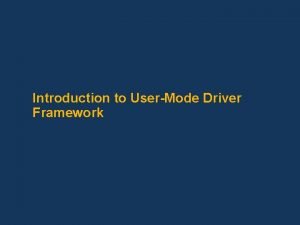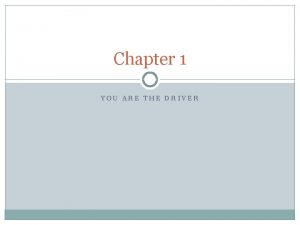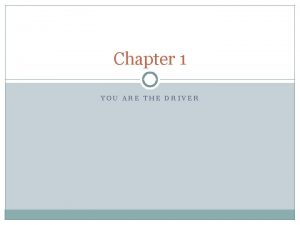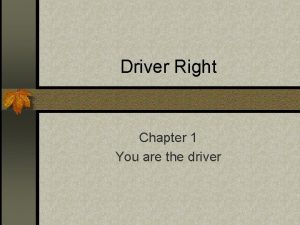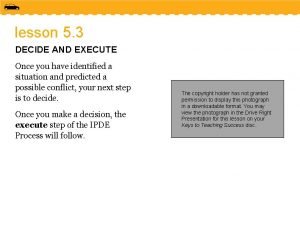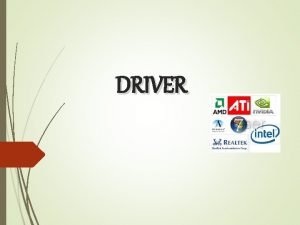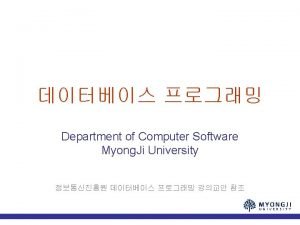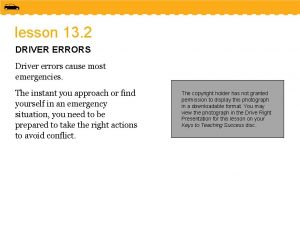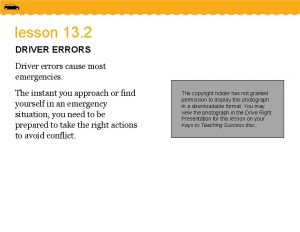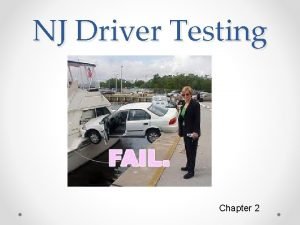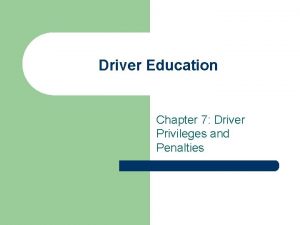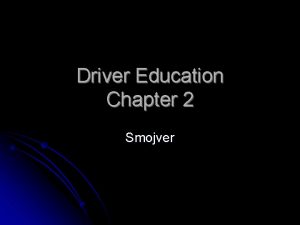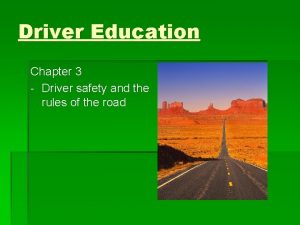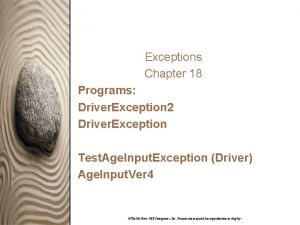Chapter 1 You are the Driver Lesson 1

















- Slides: 17

Chapter 1 You are the Driver

Lesson 1. 1: You are part of the system • The key to becoming a safe and responsible driver is to learn about the RISKS, and how to manage them. • Even the best drivers always have the potential to be hurt or hurt others. All it takes is one small mistake to lead to a major accident.

The Highway Transportation System The highway transportation system (HST) has three major parts 1. Roadway users 2. Vehicles 3. Roadways The purpose of the HST is to move people and cargo from one place to another in a safe manner. • DRIVERS ARE THE MOST IMPORTANT PART IN MAKING SURE THE HTS IS SAFE. • • •

Roadway Users • People who use the HTS by walking, driving or riding are called roadway users. • Many people are safe drivers, but there are many that are not due to bad habits, tired, sick or distracted. • You MUST be alert at all times for these drivers to protect yourself and reduce the risk of an accident.

Vehicles • There are more than 240 million registered passenger vehicles in the USA. • There are many different types of vehicles from mopeds to tractor trailers. • These vehicles vary in safety features and visibility, so you MUST learn how to share the road with vehicles of different sizes to avoid risks.

Roadways • The HTS involves more than 4 million miles of paved roads. • Roadways need extra attention when driving at night, on unlit roads, on unpaved surfaces, in rain, snow, wind or into the sunlight. • These variables add to the risks of accidents.

Regulating the HTS • Federal, state and local government agencies work together to regulate the HTS. • REVIEW: Page 5 • Take 10 minutes to answer questions 1 -4

1. 2: Your Driving Task • Your task includes all mental, social and physical skills required to drive. • • You must develop habits for: Using knowledge and visual skills Judging speed, time and space Anticipating how your car will respond under ordinary and emergency conditions

Skills MENTAL Skills: • You need critical judgment and continuous monitoring of the roadway to be alert for unpredictable actions. Social Skills: • Driving requires you to interact with other people • You need to be courteous and work well with other drivers to prevent road-rage. Physical Skills: • You need hand-eye coordination and the ability to accelerate and brake smoothly.

I. P. D. E • The IPDE process is a system used for seeing, thinking and responding while driving. It is an acronym that stands for: • I-identify important information while driving • P-predict when and where possible conflicts may develop • D-decide when, where and how to communicate, adjust speed or change position to avoid conflict • E-execute the correct actions to prevent conflict • Review pg. 7, answer questions 1 -4

1. 3: Your Driving Responsibilities • Driving is a PRIVILEGE given to the people that meet certain requirements decided by state law. • Like every privilege, you have responsibilities, and you are expected to follow your responsibilities on the road by law.

Legal Responsibilities • Laws: your primary responsibility as a driver is to obey all traffic laws. It is imperative that you avoid drinking and driving. • Collisions: Sometimes no matter how good a driver you are, you might not be able to avoid a collision. • A collision is defined as a crash that happens when a vehicle hits another object, whether the object is moving or not. • By law, any driver involved in a collision must stop.

Financial Responsibilites • You the driver are responsible for your operating cost that includes fuel, oil and tires. • You have to pay fixed costs which include purchase price of your car, any licensing fees and your insurance. • You may have to pay crash costs which is paying for injuries and damages you may cause to another person or car if the crash is your fault.

Environmental Responsibilities • All drivers have the responsibility to help manage environmental threats created by car use that may include air pollution, water pollution, chemical spills and vehicle disposable products. • Ways to be responsible and reduce pollution: • 1. Buy and maintain a fuel-efficient vehicle • 2. use fuel-efficient driving habits • 3. use car pools and public transportation • 4. recycle used materials

Responsibilities to Yourself and Others • You must make rational decisions as a driver • Driving recklessly and aggressively are examples of how not to be responsible when driving. • By showing courtesy and controlling your anger or frustration is how you can use good judgment and self-control when driving. • When driving with friends, DO NOT let them influence you to make risky decisions, because your and their life is too important. • Pg. 10, answer questions 1 -4

1. 4 Your Driver’s License • The purpose of a comprehensive driver licensing program is to make sure only safe drivers are allowed on public roadways. Most licensing programs require applicants to take written, physical and driving exams

References • Pearson: Drive Right eleventh edition
 Antigentest åre
Antigentest åre User mode driver framework
User mode driver framework Chapter 1 you are the driver worksheet answers
Chapter 1 you are the driver worksheet answers Alabama driving manual chapters 1-4 answers
Alabama driving manual chapters 1-4 answers Three parts of the highway transportation system
Three parts of the highway transportation system Chapter 1 lesson 1 your total health lesson 1 quiz
Chapter 1 lesson 1 your total health lesson 1 quiz Identify predict decide execute
Identify predict decide execute Hình ảnh bộ gõ cơ thể búng tay
Hình ảnh bộ gõ cơ thể búng tay Frameset trong html5
Frameset trong html5 Bổ thể
Bổ thể Tỉ lệ cơ thể trẻ em
Tỉ lệ cơ thể trẻ em Chó sói
Chó sói Tư thế worm breton
Tư thế worm breton Alleluia hat len nguoi oi
Alleluia hat len nguoi oi Kể tên các môn thể thao
Kể tên các môn thể thao Thế nào là hệ số cao nhất
Thế nào là hệ số cao nhất Các châu lục và đại dương trên thế giới
Các châu lục và đại dương trên thế giới Công thức tính độ biến thiên đông lượng
Công thức tính độ biến thiên đông lượng

